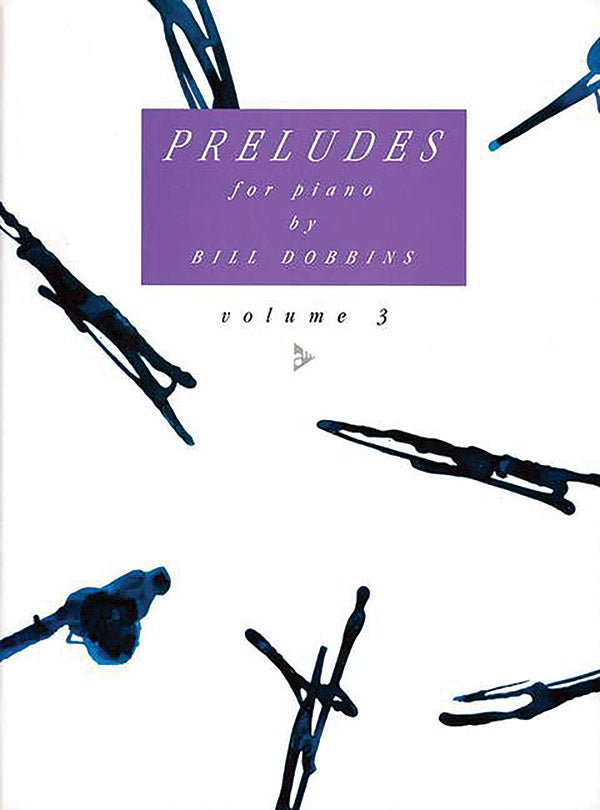Dobbins: Preludes for Piano - Volume 3
Expected to ship in about a week.
- Composer: Bill Dobbins (1947-)
- Instrumentation: Piano
- Work: Preludes
- ISMN:
- Size: 9.0 x 12.0 inches
- Pages: 40
Description
Six preludes for solo piano using vocabulary from both the classical and the jazz traditions. Prelude XIII (G-flat) focuses on a lovely right hand melody that sits on top a constantly shifting set of rich and increasingly chromatic harmonies. The first improvised section suggests Debussy colors, while the second improvisation calls for a more traditional harmonic relationship, giving the pianist ample opportunities to discover intriguing roads to travel. Prelude XV (B) is a hauntingly beautiful waltz that cries out for tenderness and sensitivity in both the written and improvised sections. As with so much of Dobbins writing, the prominence of singing melodies over complex yet appealing sonorities allows the pianist to access a wide tonal range at the keyboard. Prelude XVII (E) is a brilliantly conceived study for the left hand alone. Again dipping into his rich harmonic "bag of tricks", Dobbins provides the pianist broad stokes with which to paint. Prelude XVIII (in C-sharp Minor) is a rhythmic tour de force, a modern jazz etude that demands a strong drive, steel fingers, and a quick touch. As in the previous two sets of Preludes, Dobbins has given the modern pianist a veritable new world to explore and to bring to modern audiences. He is challenging each kind of pianist (the non-improvising classical and the jazz pianist who may not perform written scores as a rule) to introduce themselves to the others way of communication. and in doing so, he is providing a fascinating, pianistic, and unique set of pieces, and possibilities for personal expression that become ever more personal each performance.
Publishers use a lot of words to describe what they sell, and we know it can be confusing. We've tried to be as clear as possible to make sure you get exactly what you are looking for. Below are descriptions of the terms that we use to describe the various formats that music often comes in.
Choral Score
A score for vocalists that only contains the vocal lines. The instrumental parts are not there for reference. Generally, cheaper than a vocal score and requires multiple copies for purchase.
Facsimile
Reproductions of the original hand-written scores from the composer.
Full Score
For ensemble music, this indicates that the edition contains all parts on a single system (there are not separate parts for each player). In larger ensembles, this is for the conductor.
Hardcover
Hardbound. Generally either linen-covered or half-leather.
Orchestral Parts
Similar to a wind set, this is a collection of parts. In the case of strings, the numbers listed are the number of copies included, though generally these are available individually (often with minimum quantities required).
Paperback
When publishers offer multiple bindings (e.g. hardcover) or study scores, this is the "standard" version. If you're planning to play the music, this is probably what you want.
Performance / Playing Score
A score of the music containing all parts on one system, intended for players to share. There are not separate parts for each player.
Set of Parts
For ensemble music, this indicates that there are separate individual parts for each player.
Solo Part with Piano Reduction
For solo pieces with orchestra, this is a version that contains a piano reduction of the orchestra parts. For piano pieces, two copies are typically needed for performance.
Study Score
A small (think choral size) copy of the complete score meant for studying, and not playing. They make great add-ons when learning concertos and small chamber works.
Vocal Score
A score prepared for vocalists that includes the piano/organ part or a reduction of the instrumental parts.
Wind Set
For orchestral music, this is a collection of wind and percussion parts. The specific quantities of each instrument are notated.
With Audio
In addition to the printed music, the edition contains recordings of the pieces. This may be an included CD, or access to files on the internet.
With / Without Fingering (Markings)
Some publishers prepare two copies - a pure Urtext edition that includes no fingering (or bowing) suggestions and a lightly edited version that includes a minimal number of editorial markings.


